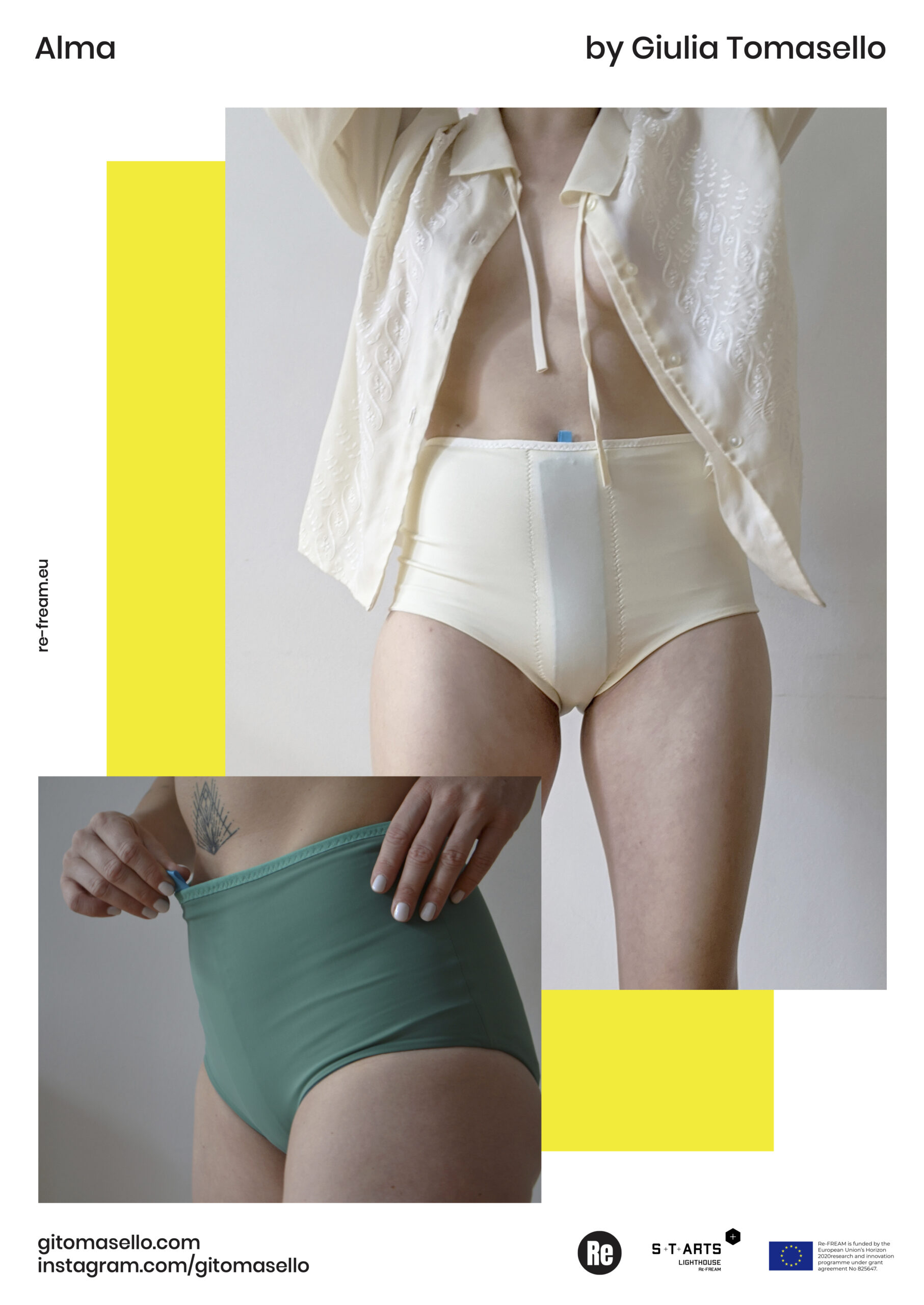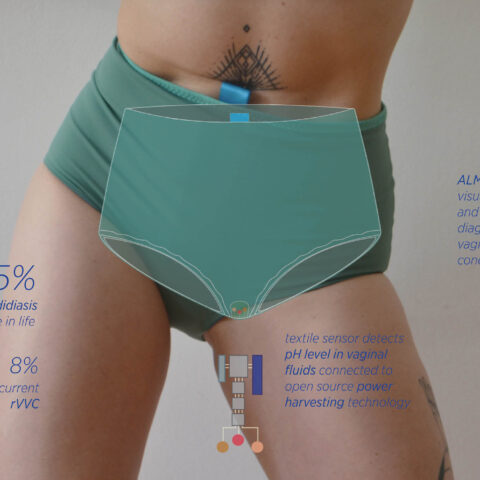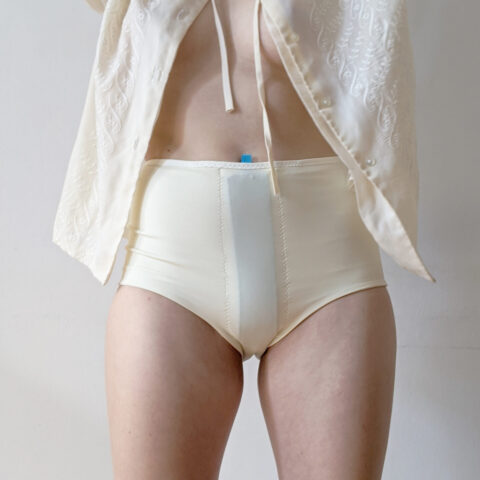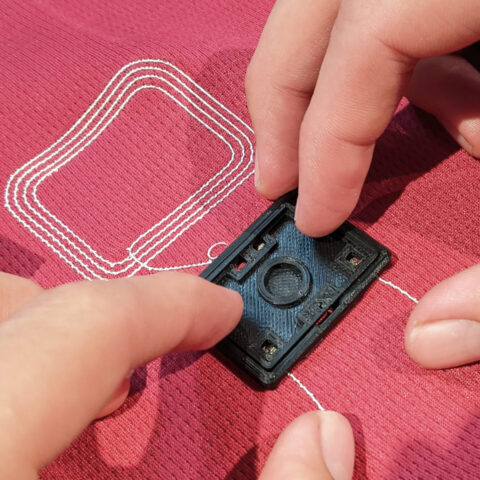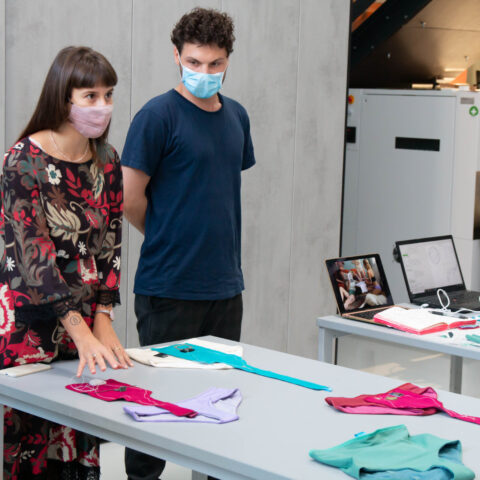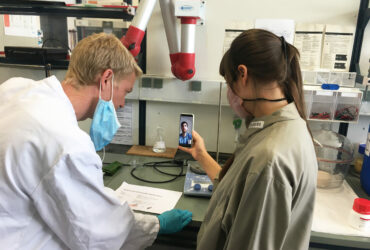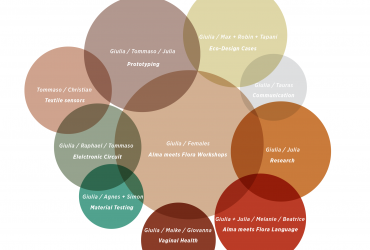ALMA underwear unlocks the power of seams and e-textiles to expand awareness, shape female health confidence, and transmit autonomy. The project combines design technology and anthropology to co-create tools for both female intimate care and cultural change. Technological tools include biosensors embedded in underwear which measure vaginal fluid pH. Educational tools include a community platform to educate women* about self health. Both aim to empower citizens to become active participants in their personal health, overcoming concepts of shame and silence surrounding female bodies.
ALMA is a wearable biosensor designed to monitor vaginal fluids, at the intersection of healthcare and fashion. The co-creation process took place in Berlin, across different departments of Fraunhofer IZM, ranging from the textile to the chemistry lab. Embedded electronics in underwear means working with very small wearables, Tomasello explains: “everything is quite delicate – it’s not about how far the microprocessor is from the sensor, but how comfortable it is”.
The non-invasive wearable device use e-textiles with specialized coatings to monitor vaginal discharge. The goal is to help women* suffering from recurring gynecological conditions, such as vaginal infections, which can have many repercussions on their quality of life. It also addresses the taboos around urogynecological infections, which may hinder women* seeking help and puts them at risk of medical complications.
With the help of Fraunhofer IZM, the team managed to move the sensor from a plastic substrate into a thread substrate. They developed a sensor with threading in silver and gold, which was coated with a chemical process to become a pH sensor. Using the Fraunhofer industrial embroidery machine, this sensor was connected to a microprocessor, made with an open-source project from the University of Washington. The team co-developed functioning lab prototypes – including textile antennas – capable of measuring fluid pH using the textile substrate.
They produced four pairs of this new kind of underwear, in red, green, purple and off-white, in two different styles: a 50s style and a basic style. The designs aim to reflect the spectrum of diversity the ALMA team encountered in participatory workshops called ALMA meets Flora.
The project uses the symbolic quality of apparel, unlocking the power of fashion to change attitudes. It also uses open-source biology as a tool to empower citizens to become active participants in their personal health. Fashionable underwear and measuring vaginal chemistry are combined to close the medical gender gap and raise awareness about the female body.
Rooted in the values first promoted by the Boston Women’s Health Book Collective in the 1970s, the aim is to provide women* with knowledge about their intimate health through technology. ALMA aims to raise consciousness and generate critical conversations about taboos surrounding feminine hygiene and provide alternatives to intimate self-care.
On the one hand, new funding is allowing the team to progress on shrinking the full antenna and microprocessor into a one size pad. On the other, the team is also exploring low-tech bio-textiles options revolving around color change response. ALMA aims to collaborate with a wide variety of designers to collect different low tech approaches that they can propose to their community. Surveys and workshops on how wearable technology can further improve the life of females have also led the team to better understand other issues they could address, including fertility challenges, gynecological problems, abnormal uterine bleeding, and menopause.
While the product development aims to eventually generate an income stream, an additional goal is the digital platform, which functions as a social enterprise, collaboratively raising awareness.
“We’re really talking about years and years for a shift in society”, Tomasello explains: “Many female founders are working towards this direction, to not just create businesses with a patriarchal or hierarchical attitude, but towards more multidisciplinary participatory business models”.
The Project
Alma is a wearable biosensor designed to monitor vaginal fluids. We strive to support and educate women* about their intimate health through technology. Our team of designers, anthropologists, scientists and engineers has co-developed with our industrial partners, Fraunhofer IZM and Empa, a new type of underwear capable of measuring vaginal fluid pH. Quantifying vaginal chemistry is an important step to close the medical gender gap and raise awareness about the female body. Our entire design process was driven by the data and insights from the Alma meets Flora survey and co-design workshops.
The Partners
ALMA collaborated with the Smart Textile Hub of Re-FREAM, specifically with Fraunhofer IZM. Empa provided consulting.
The Technologies
In collaboration with Fraunhofer IZM, the team shifted from a sensor made in PET film to one created with a textile substrate. The sensor is made of two parts: the working electrode and the reference electrode. The co-creation started with the reference electrode manufacturing. A silver-coated textile was modified to silver/silver chloride textile. The final sensor successfully measured pH solution in the lab.
The team built a modular design, embedding the technology in the gusset of the underwear, where the pH sensor is located. The data is conducted through conductive wires to a small encasement of electronics. The modularity allows the sensor to be easily removed when washing the garment.
The prototype features wireless communication that can potentially allow a female to access her own information through an app, which could encourage her to seek appropriate help when needed.
Robin Hoske, Fraunhofer IZM, about the project
“Team Alma set up an impressive participatory process by actively giving users a central role in development. These involved women from different parts of the world and combined insightful knowledge and evidence from thematic workshops with findings from applied research in the lab. Their research shows that emphatic knowledge and user participation are necessary to develop acceptable technological scenarios in a very intimate environment.
Together with the ALMA team, Fraunhofer IZM realized a textile-based pH-sensor integrated into underwear. It works with energy induction, thus avoiding a battery, and uses a novel micro-controller and textile antenna solution.”
“My aim as designer is to sparkle critical conversations on feminine hygiene and the surrounding taboos, to raise awareness and provide alternatives to intimate self-care. I envision women’s body in the intersection of biotechnology and healthcare. Empowering citizens through open-source biology, to become active participants in their personal health.
Coded Bodies as teaching practice, introduce basics of Arduino coding, soft wearables, e-textiles prototyping and the exploration of bio-textiles. Future Flora, STARTS Prize 2018, is a harvesting kit designed for women to prevent vaginal infections, and wear live bacteria in the panties. Rethinking the Bra is a new type of bra that truly embraces the female body, an on-going project with designers S.Schidlowski and E.Mikkola.”
Follow Giulia




